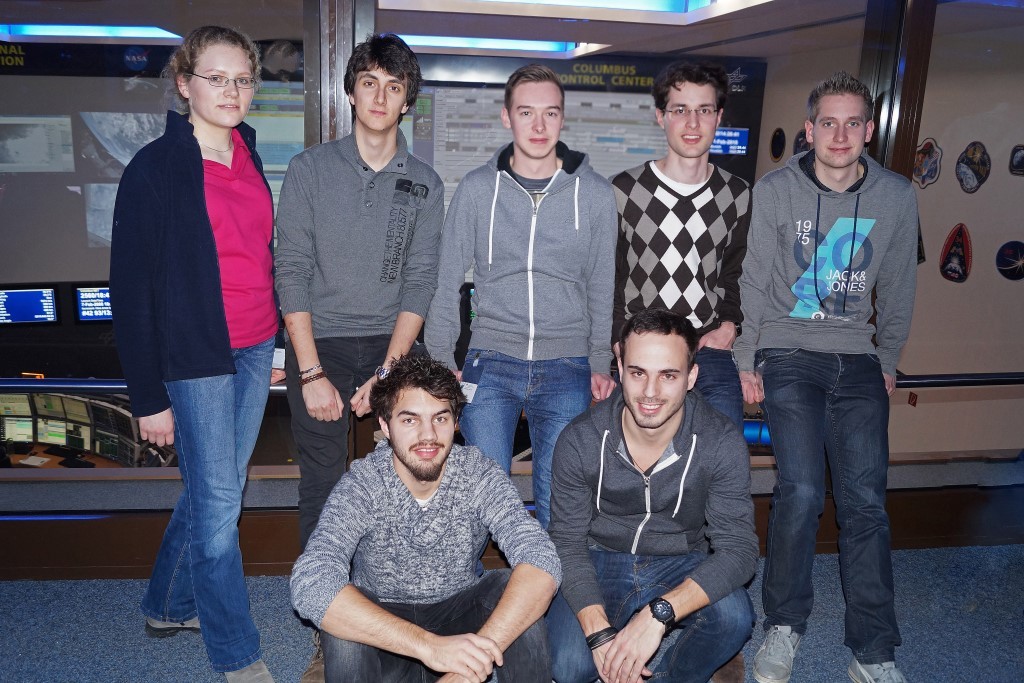PATHOS is a students’ experiment for the REXUS-program of the German Aerospace Center (DLR) and the Swedish National Space Board (SNSB).
During the next 18 months a team of eight students will design and build this experiment that will fly on the REXUS rocket.
The team

PATHOS Team:
back LTR: Elke Heidmann, Liviu Stamat, Dominik Wagner, Moritz Aicher, Jonas Ehnle
front LTR: Bastian Klein, Florian Kunzi (missing Felix Klesen)
We are a team of eight students of the Julius-Maximilians-University in Würzburg.
In autumn 2014 we are in the third semester of our degree course aerospace information technology.
We are supported by the Chair of Computer Science VIII of our university, especially by Prof. Dr.-Ing. Hakan Kayal, Dipl.-Inf. Gerhard Fellinger and M.Sc. Wendelin Fischer.
PATHOS – our experiment
PATHOS is the acronym for Position-vector Acquisition Through Horizon Observation.
It is a sensor which can determine attitude information of a spacecraft by using video data.
The sensor takes video data with usual cameras.
An algorithm processes the pictures. It recognizes the earth’s horizon and uses this line to calculate a vector towards the earth center.
With the flight on the REXUS rocket we want to test if the PATHOS-sensor works properly. The rocket reaches a height were one can see the curvature of the earth. Furthermore with the spinning and tumbling of the rocket we can simulate stress conditions. We want to show that even these movements are no problem for the sensor.
Besides of the PATHOS sensor we have to build an infrastructure to command the experiment, to provide power and to store the data.
For satellites there are emergency cases like uncontrolled spinning and tumbling. In these situations it’s very important that the satellite can stop this movement quickly.
The PATHOS sensor could help by getting attitude data even under these stress conditions.
HORACE – the predecessor experiment
We got the idea for the experiment in summer 2014 when our fellow students gave a presentation on their REXUS project HORACE. This experiment was launched in May 2014 on REXUS 16.
HORACE is an experiment with the same task. It gets attitude information by processing video data.
The HORACE team did a really good job. The algorithm and the complete structure work well.
Unfortunately the team had a small problem with the camera. So they couldn’t take usable pictures during the rocket flight and therefore they were not able to prove the system under real conditions.
PATHOS will be an advancement of HORACE.
We take HORACE as basis and use the knowledge of this experiment.
As the algorithm of HORACE worked well in simulations we will use it again and just add some enhancements.
Furthermore we will miniaturize the PATHOS sensor.
For more information about the HORACE-Experiment look at http://horace-rexus.de/
The REXUS Project
The REXUS (Rocket Experiment for University Students) Program provides students the opportunity to place an experiment on a sounding rocket. In that way they can use certain conditions for example reduced gravity and pressure for scientific or technical experiments.
One of the main aspects of the project is that students take part in all development phases and are responsible for their own experiment. Firstly they have to think of the topic the experiment is about. Later the students implement and test the experiment. Of course it’s also necessary to write documentations.
During the project experts of the DLR and ZARM (Center of Applied Space Technology and Microgravity, Bremen) supply the students in technical and organizational issues.
The REXUS program is based on a bilateral Agency Agreement between the German Aerospace Center (DLR) and the Swedish National Space Board (SNSB).
For more information about the REXUS-Project look at http://www.rexusbexus.net/
